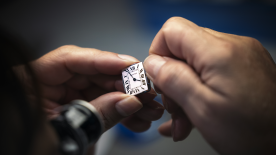Asymmetry is fascinating. Artists, architects and designers have been addressing this subject throughout history. The examination of asymmetry and symmetry has brought together the media artist and choreographer Christian "Mio" Loclair and A. Lange & Söhne. Together with his studio, Waltz Binaire, he realised a project at the Finca Bell-Lloc in Girona, Spain, that analysed the interaction between design, mathematics and nature through words and movement.
Two different physical bodies move within an empty room. A mechanical male body forms the opposition to an organic female body. At first, they are separate from one another and we notice the beauty of both types of movement. We experience how the two units encroach on each other and overlap. The interaction on the interface between mathematics and nature epitomises physical nature and the rhythm of asymmetry.
For Loclair, good design begins with a decision based on the law of proximity, which originates from Gestalt psychology: “If we add a new element to an existing group of elements, we have to take the altered balance in the space into consideration. We are always creating new connections and find our way towards simplicity through this complex mathematical process.”
The balancing of asymmetric proportions also forms the core of the Lange 1 design philosophy. The complexity within, which gives rise to a new kind of harmony resulting from the off-centre display designed in accordance with the golden ratio, remains timeless and ground-breaking, even after a quarter of a century. A new, organic sense of order results from the perceived imbalance, corresponding to human experience and giving the watch its iconic character.
Asymmetry is the leitmotif of the Lange 1 design, imparting an inimitable appearance. The off-centre displays without any overlaps create a captivating sense of tension. Nevertheless, the dial looks ordered and harmonised. This is due to the fact that the displays are in a delicately balanced relationship with one another. It conforms to classic design rules such as axial arrangement and the golden ratio.
In geometry, two quantities are in the golden ratio if the ratio of the sum of the two quantities is the same as the ratio of the larger quantity to the smaller quantity. Expressed as a number, this is a ratio of one to 1.618. This magic number has inspired thinkers since antiquity and appears in the works of renowned artists such as Leonardo da Vinci and Le Corbusier. On the Lange 1, the proportion of the diameters of the dial and the hour and minute circles is in the golden ratio, just like the proportions of the out-size date display.





